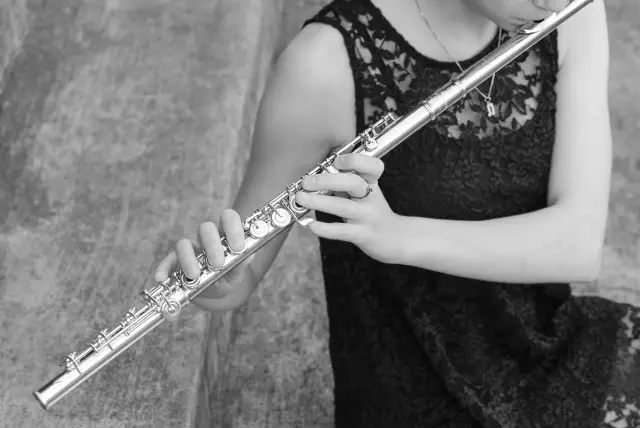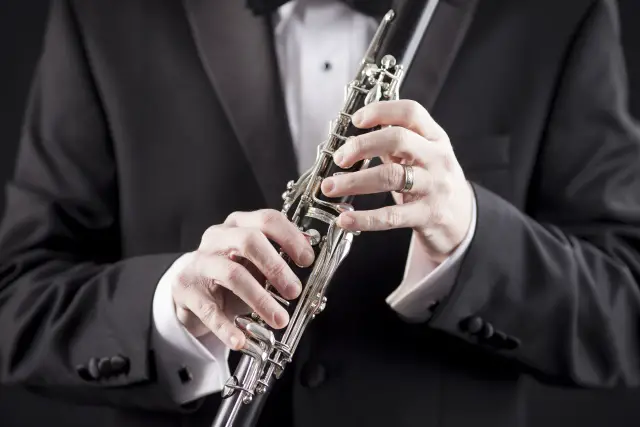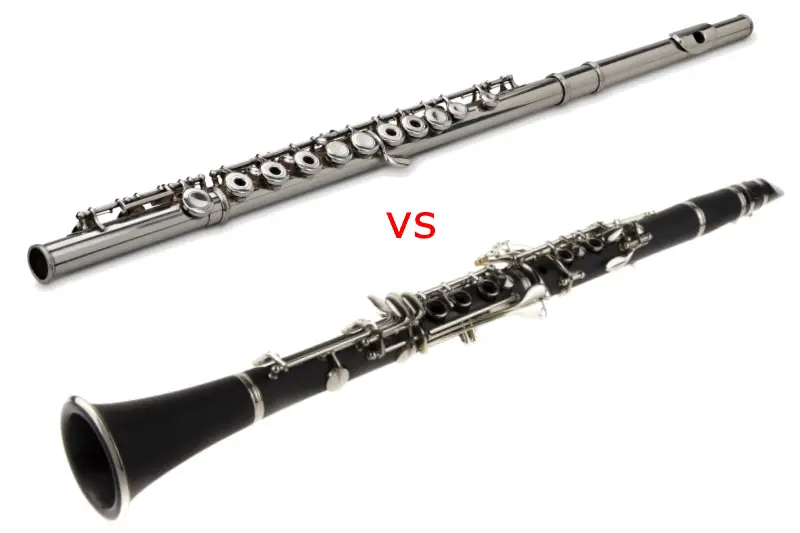Should I learn the flute or clarinet? Which instrument is easier to learn and play? I often get these questions, and there isn’t a simple answer..
The flute and clarinet each have easier and harder aspects. The clarinet is hard because you have to work with a reed, and there are open holes. Some players find the flute more challenging because it’s harder to get a good sound, balancing is trickier, and it needs to be played fast.
Whether one finds the flute or clarinet harder depends on many factors. There are significant differences between the two in terms of embouchure and breadth control, posture and balance, notes and register, and fingerings.
See also:
Best flute for doublers
Which is easier, flute or piccolo?
9 reasons why the clarinet is so popular
Table of Contents
Clarinet vs flute: which is easier to produce notes on?

Clarinet vs flute sound production
The way to make sound on these two instruments is quite different. For clarinet, a single reed vibrates against a mouthpiece. You place the reed on the mouthpiece, then the tip of the mouthpiece in your mouth.
Luckily, once you learn the correct embouchure – i.e. how you shape your mouth to play, your embouchure basically remains the same for all of the notes.
When playing the clarinet, the embouchure needs to be firm, with the muscles of your mouth making a tight seal around the mouthpiece. For a beginner, this can be tiring. Eventually though, those muscles become stronger.
With the flute, you blow air across a hole in the head joint. Because the flute is different from the clarinet in how it produces sound, there is a different way to form your embouchure.
It’s a little trickier, because to play notes from very low to very high, you must adjust your embouchure slightly throughout. It may also take more time to produce a clear, beautiful tone.
Some people are able to make a sound on the flute right away. They’ll tell you it’s very easy. Many, however, find it challenging at first, though they usually get it eventually.
Even professional flutists and clarinetists continue to work on improving their embouchure, because it’s a very important part of achieving a pleasing sound.
Clarinet vs flute breath support
Both instruments require strong breath support in order to produce a good sound. On the clarinet, the player needs to blow hard enough that they fill the entire instrument with air all of the way to the bell. This can be hard to do for the learner.
On the flute, the player must keep a focused air stream moving, with a small opening of the mouth. This also takes time to perfect.
Learning the notes
The term “register” is basically a way to describe how high or low instruments are playing. Beginning clarinet students usually learn the notes in the lower register first. These have an easier response when just starting out.
The clarinet is an open-holed instrument. This means that the player changes notes by opening and closing holes. To work correctly, the holes must be completely covered. Otherwise, the note won’t come out, or the clarinet might squeak.
Flute students frequently learn the middle and upper register notes first. These come out more naturally for beginners.
Beginning flutes are most often close-holed. This makes fingering easier on flute because you don’t have to be as precise as on the clarinet.
Check out some of the best selling clarinets on Amazon or on Guitar Center
Clarinet vs flute posture

Holding the instrument correctly is vital to playing well, and the flute and clarinet are held differently from one another.
The clarinet aims vertically down to the floor. It can feel heavy, especially for young beginners. The right thumb bears most of the weight. Some choose to use a neck strap to help take much of the weight off of the thumb.
The flute aims horizontally out to the right of the player. It’s somewhat lighter than the clarinet, but keeping your arms in the right position to hold it up correctly can be tiresome.
For both the flute and the clarinet, the trick is to learn how to balance them correctly. With the clarinet, the right thumb pushes up on the thumb rest against the embouchure’s hold on the mouthpiece.
There are more balance points for the flute. The instrument is held correctly by the left-hand index finger, the right thumb, the right pinky on the low Eb key and the chin.
With the flute and the clarinet, if you’re holding the instrument correctly, it doesn’t move around. That way, the fingers are free to move how they should.
Embouchure: reed vs no reed
Some would say playing the clarinet is harder than the flute because you need a good reed and mouthpiece that work well. If you’re playing on a bad reed or mouthpiece, even the perfect embouchure might not be able to help.
A good embouchure on the clarinet involves the lower lip covering the lower teeth, acting like a cushion for the reed. The top teeth rest on the top of the mouthpiece. Then the mouth closes firmly around the mouthpiece, forming a seal.
As mentioned above, the embouchure needs to be quite solid and steady, which can be tiring. It’s important to develop the muscles involved so that they become stronger.
In many ways, forming the embouchure to play the flute is easier than the clarinet. However, for many, getting a good sound is harder.
The head joint is placed with the bottom of the lip plate resting just below the lower lip. To blow air across the tone hole, the player often thinks of saying the word “pooh,” keeping the lips soft.
Each flute player is slightly different, so it may take some time to find the exact placement that produces the best sound. The embouchure must remain relaxed so that it can be flexible.
Without the added variable of the reed, the flutist can concentrate on blowing the air across the hole in the head joint with control. Many feel that the flute embouchure is less tiring than the clarinet embouchure.
Clarinet vs flute fingerings

The fingerings for different notes are somewhat similar for the flute and the clarinet. But there are differences which make the clarinet a bit more challenging.
The basic range of the flute is C4 to D7 in treble clef, although occasionally the music calls for higher notes. Some flutes have a B foot, which extends the low range down to B3.
For the flute, the fingerings for the two main registers or octaves a beginner learns are the same. They play in a different register by making a slight embouchure adjustment.
The holes of the flute are closed, making fingering easier. But the flute is often asked to play very fast, so the player needs to develop good technique.
The clarinet range is concert D3 to Bb7 in treble clef. This is nearly four octaves. On the clarinet, the notes of the two main registers are different. So, if you play the clarinet, you need to learn more fingerings. The holes are open, making fingering a bit more complicated.
The clarinet is also able to play more notes than the flute. This is a plus, but it also means more fingerings to learn.
See also: How long does it take to play the clarinet?
Challenges of switching from flute to clarinet
The biggest challenge for a flutist who is learning the clarinet is the different embouchure. The muscles are used very differently to produce a sound on the clarinet. They would need to get used to working with a reed and a mouthpiece.
Playing an instrument with open holes is also more difficult. The player must have the right hand position in order to close the holes exactly.
Some fingerings are the same on the flute and clarinet, so a flute player who wants to switch would have a head start on learning the fingerings.
Other differences between playing flute vs clarinet
The flute involves less gear. The instrument itself only has three pieces, the head joint, the body and the foot joint. The clarinet has seven pieces involved, the reed, mouthpiece, ligature, barrel, upper joint, lower joint and bell.
The flute is quicker to assemble and disassemble. To assemble, the flutist puts the three pieces of the instrument together.
The clarinetist wets the reed, puts the six pieces of the instrument together, then carefully attaches the reed in the right place on the mouthpiece with the ligature.
To disassemble, the flute player uses a rod and a polishing cloth to dry out the three pieces of the instrument.
The clarinet player carefully puts away the reed in a case, puts a mouthpiece cap on the mouthpiece, then uses a swab to dry out each of the five remaining pieces of the instrument.
The flute is traditionally played using vibrato. This is a fast, but slight variation in pitch which makes the sound stronger and richer. The clarinet doesn’t traditionally use vibrato, except in jazz.
Ultimately, it will be easier to learn an instrument you really like. If you prefer the rich and mellow sound of the clarinet, you should choose the clarinet. If you like the way a flute can play clear, high and twirly, choose the flute.
Final words
Both the flute and the clarinet have things about them that are picked up quickly, and things that take time. Some players will say that the flute is more challenging because it’s hard to get a good sound, and that they are always asked to play fast.
Others will say that the clarinet is harder because you have to work with a reed, and there are open holes.
They are both challenging, but the reward makes it well worth it.

